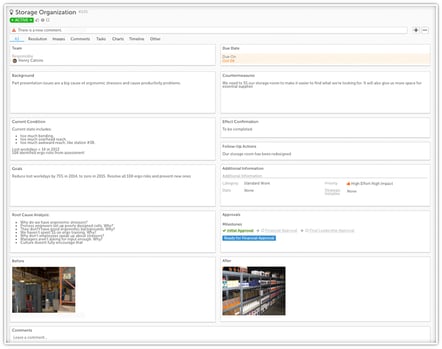 Most companies today work to improve their performance continuously. The basis of this improvement is practical problem-solving. Unfortunately, many organizations are not very adept at solving the day-to-day, year-to-year problems that they face. Most are very good at emergency firefighting but not as effective at solving the root causes and ensuring that problems don't recur.
Most companies today work to improve their performance continuously. The basis of this improvement is practical problem-solving. Unfortunately, many organizations are not very adept at solving the day-to-day, year-to-year problems that they face. Most are very good at emergency firefighting but not as effective at solving the root causes and ensuring that problems don't recur.
One company that figured it out is Toyota. Toyota's approach to continuous improvement is among the most studied and copied in the world. Many of the tools and techniques they practice are replicated in organizations of all types and sizes across the globe. One such method is called A3 process mapping. When used with the PDSA improvement cycle, it can significantly impact an organization's improvement efforts and deliver structured change that impacts critical business metrics.
What is A3 Process Mapping?
The A3 process mapping methodology was first used by Toyota in the 1960s and subsequently adopted by leaders who implemented Lean, Total Quality Management, Six Sigma, and other structured approaches to continuous improvement. "A3" refers to a European paper size of about the same size as an American 11-inch by 17-inch tabloid-sized paper. Using the A3 process mapping, teams create a one-page PDSA (Plan, Do, Study, Adjust) improvement project report. By keeping the report to one page, it must be concise and include only relevant information needed to solve problems.
Why Use A3 Process Mapping?
There are several reasons that A3 thinking is so popular. Among them are:
- Accelerated problem-solving: By applying a step-by-step visual process with logical reasoning and insisting on root-cause identification, teams ensure that issues are resolved, not just temporarily covered up.
- Team development: The use of a consistent tool across the company promotes cross-functional collaboration and widespread knowledge sharing.
- Company growth: A3 process mapping helps document company knowledge, sustain strategy deployment, and build a strong culture rooted in problem-solving rather than abstract ideas.
- Increased employee engagement: When people know precisely what is expected and have the right tools to document and measure their efforts, they are more likely to identify opportunities for improvement and engage in constructive change.
The 7 Steps in an A3 Project
Of course, every company uses the A3 technique in its own way, but generally, there are seven steps in an A3 project.
1: Background
At the outset, those involved in the project make the business case for selecting this specific problem for resolution. Then, the A3 map must clearly state how the issue impacts measurable business objectives around customer value, waste reduction, safety, satisfaction, revenue, or other strategic goals.
2: Problem Definition
This section outlines the specifics of the problem. Details may include the scope of the problem, where and when the problem occurs, and the problem's impact on business metrics. By having these specifics on a quantitative scale, the A3 report brings the problem to life for the organization.
3: Goal Statement
This section outlines what the team is trying to accomplish by initiating the A3 process mapping project. Clearly state the goals you are trying to achieve and set a timeframe for completion.
4: Root Cause Analysis
Once the problem is apparent, the team will conduct a root cause analysis to find the most fundamental reasons for this problem. The 5 Whys technique can be an effective way to make sure the fundamental reason for the issue is found.
5: Countermeasures
With the root causes clear, the next step is to document the countermeasures that you will use in solving the problem. This section forms a detailed plan outlining who will deploy the countermeasures and when they will be completed.
6: Confirmation
Once the countermeasures are implemented, it is time to analyze the results. Now you can determine whether the results prove that your countermeasures were effective in meeting your goals.
7: Follow Up Activities
Once you've achieved the desired results, deploy the infrastructure for sustaining the gains, including standardization, reports, and visualization. It is ideal to share the information across the organization. In Japanese, this process is called Yoko-narabi-tenkai, meaning "lateral deployment of findings to other groups."
Software for A3 Process Mapping
As we mentioned, A3 is literally named after a piece of paper. However, modern organizations have improved on the pen and paper days by leveraging software to support this problem-solving method. With A3 software, your team will enjoy:
A Standard Approach to Solving Problems: It is best to have standard A3 reports used across the organization. Software makes this easy by giving everyone a set of fields and a layout that will be the same every time a new A3 project is started. You can configure your A3 input and reporting screens to match the specific needs of your organization.
Broad Visibility: It is difficult for leaders to understand what improvement projects are underway if they are managed on physical pieces of paper or even in spreadsheets. With an A3 process mapping platform, leaders get real-time visibility into all improvement activities. As a result, supervisors and managers can provide proactive coaching and remove obstacles. This level of visibility also increases accountability and allows for the broadcasting of successful improvements.
Cross-Functional Collaboration: It is often the case that the most challenging challenges require the involvement of cross-functional teams. Cloud-based A3 software with built-in collaboration tools works so well because the right people can be involved in each A3 project, regardless of where they are located. Everyone who needs it gets access to all of the details whenever they like.
Visual Management: At its heart, A3 is a visual management tool. A3 process software supports the consistent visualization of data and the inclusion of related charts and graphs. When someone looks at a digital A3 process map, they instantly understand the problem, the solution, and the impact.
The A3 process mapping technique is a simple yet effective approach to solving even the most complex problems. Closely following the steps, standardizing on the essential elements for your organization, and implementing technology will help achieve widespread adoption and increase the chances that you'll enjoy the long-lasting results you set out to achieve.

![[WEBINAR] A Deep Dive into A3 Thinking](https://no-cache.hubspot.com/cta/default/326641/a78d9f1b-c108-4709-8a9d-9dd5a8a020b3.png)


Add a Comment